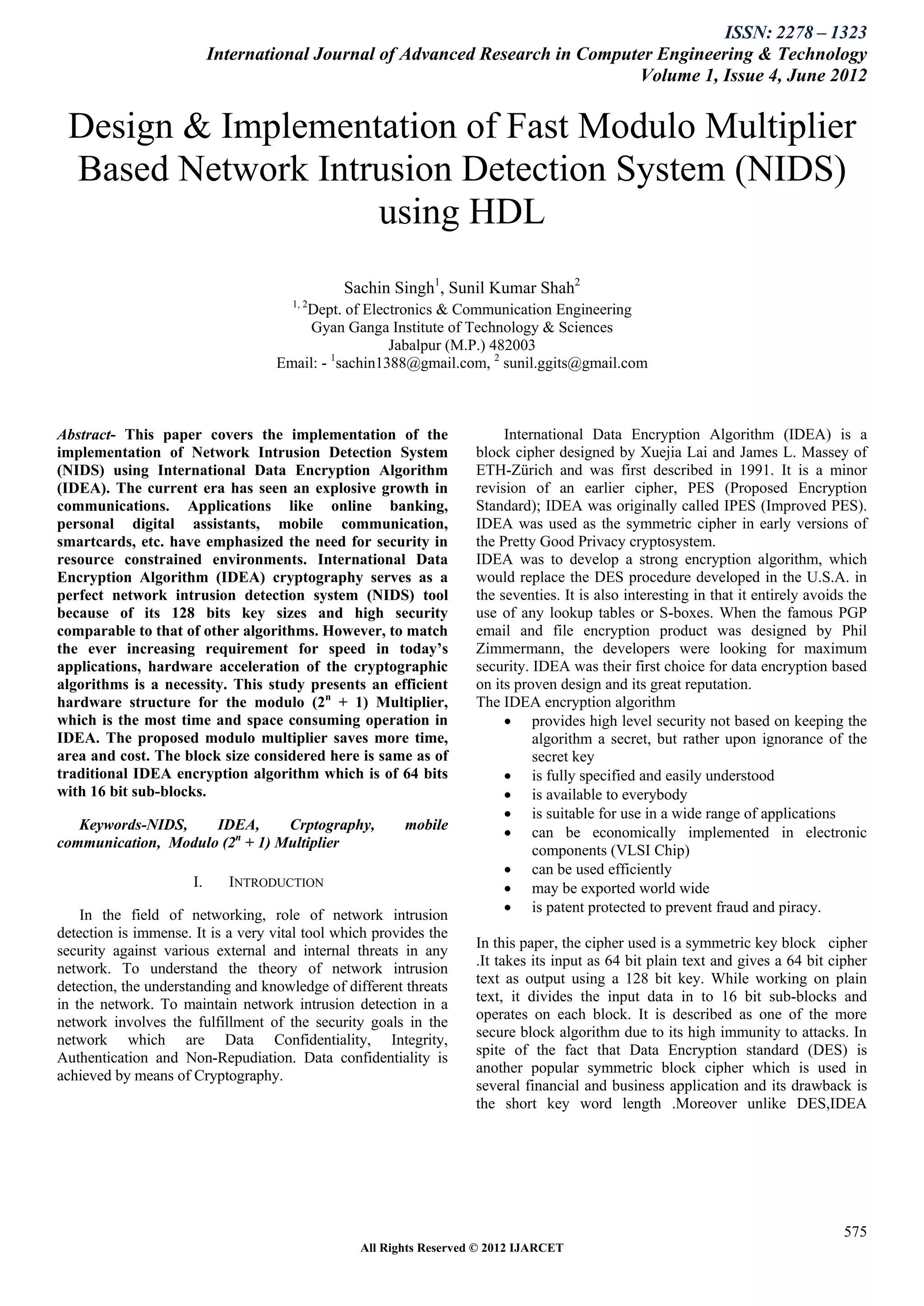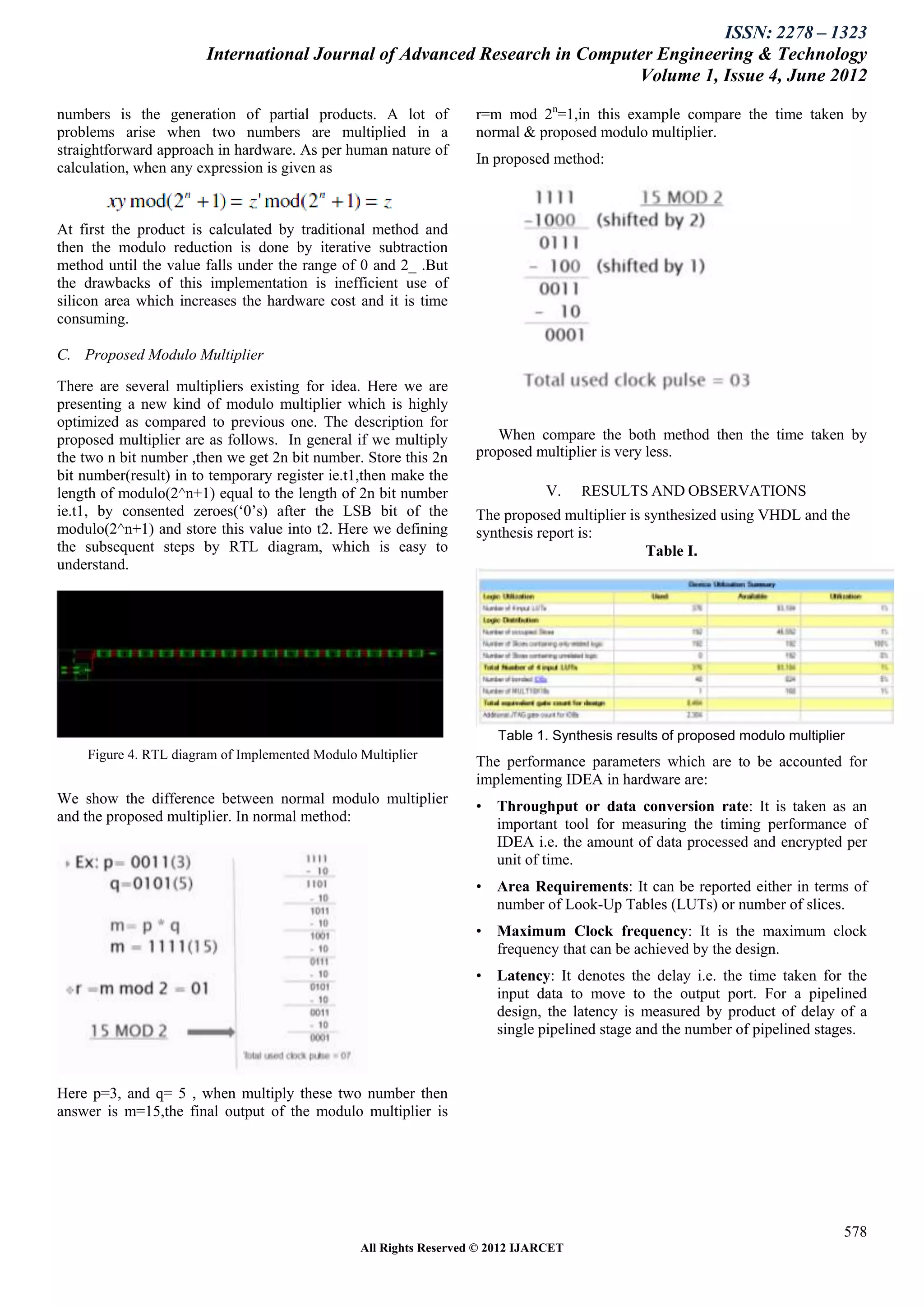This document discusses the implementation of a Network Intrusion Detection System (NIDS) using the International Data Encryption Algorithm (IDEA). IDEA is a block cipher that operates on 64-bit blocks of plaintext and uses a 128-bit key. The most computationally intensive part of IDEA is the modulo (2n+1) multiplier. The paper proposes an efficient hardware structure for the modulo multiplier to improve the speed and efficiency of the IDEA algorithm when used for network intrusion detection.




![ISSN: 2278 – 1323
International Journal of Advanced Research in Computer Engineering & Technology
Volume 1, Issue 4, June 2012
[9] Thaduri,M.,Yoo,S. and Gaede,R, “ An Efficient Implementation
of IDEA encryption algorithm using VHDL”, ©2004 Elsevier.
[10] Allen Michalski1, Kris Gaj, Tarek El-Ghazawi, “An
Implementation Comparison of an IDEA Encryption
Cryptosystemon Two General-Purpose Reconfigurable
Computers”
[11] Sarang Dharmapurikar and John Lockwood, “Fast and Scalable
Pattern Matching for Network Intrusion Detection Systems”
IEEE Journal on Selected Areas in Communications: Oct. 2006,
Volume: 24, pp. 1781- 1792 .
Figure 5. Simulation Waveform of Implemented Modulo Multiplier [12] Chiranth E, Chakravarthy H.V.A, Naga mohana reddy P, Umesh
T.H, Chethan Kumar M., “Implementation of RSA
VI. CONCLUSION Cryptosystem Using Verilog” International Journal of Scientific
& Engineering Research Volume 2, Issue 5, May-2011.
RSA Security goes on to say that IDEA was analyzed to [13] Rajashekhar Modugu, Yong-Bin Kim and Minsu Choi, “A Fast
measure its strength against differential cryptanalysis. The
analysis concluded that IDEA is immune to that technique. In Low-Power Modulo 2n + 1 Multiplier”, Journal of IET
fact, there are no linear cryptanalytic attacks on IDEA, and Computers & Digital Techniques Jan-2011.
there are no known algebraic weaknesses in IDEA. The only
weakness of note was discovered by Daemen: using any of a
class of 251 weak keys during encryption results in easy
detection and recovery of the key. However, since there are
2128 possible keys, this result has no impact on the practical
security of the cipher for encryption provided the encryption
keys are chosen at random. IDEA is generally considered to be
a very secure cipher and both the cipher development and its
theoretical basis have been openly and widely discussed.
REFERENCES
[1] Modugu.R, Yong-Bin Kim, Minsu Choi,“Design and
performance measurement of efficient IDEA crypto-hardware
using novel modular arithmetic components”, Instrumentation
and Measurement Technology Conference (I2MTC), 2010
IEEE, 3-6 May2010,pp1222-1227.
[2] R. Zimmermann, A. Curiger, H. Bonnenberg, H. Kaeslin, N.
Felber, and W. Fichtner,“A 177mb/s VLSI implementation of
the international data encryption algorithm,”IEEE Journal of
Solid-State Circuits, Vol. 29, 1994, pp. 303-307.
[3] Rahul Ranjan and I. Poonguzhali, “VLSI Implementation of
IDEA Encryption Algorithm”, Mobile and Pervasive Computing
(CoMPC–2008).
[4] Somayeh Timarchi, Keivan Navi, “Improved Modulo 2n +1
Adder Design”, International Journal of Computer and
Information Engineering 2:7 2008.
[5] X.Lai and J.L Massey “A Proposal for a New Block Encryption
Standard,” in advances in Cryptology – EUROCRYPT
90,Berlia,Germany: Springer Verlag pp. 389-404, 1990.
[6] Antti H¨am¨al¨ainen, Matti Tommiska, and Jorma Skytt¨, “6.78
Gigabits per Second Implementation of the IDEA Cryptographic
Algorithm”, 2002 Springer-Verlag, pages 760-769.
[7] M.P. Leong, O.Y.H. Cheung, K.H.Tsoi and P.H.W.Leong “ABit
Serial Implementation of the International Data Encryption
Algorithm IDEA” ©IEEE 2000.
[8] P. Kitsos , N. Sklavos, M.D. Galanis, O. Koufopavlou , “64 Bit
Blockciphers: Hardware Implementations and Comparison
analysis”,593-604,3rd November,2004,Elsevier
579
All Rights Reserved © 2012 IJARCET](https://image.slidesharecdn.com/575-579-120630095811-phpapp02/75/575-579-5-2048.jpg)